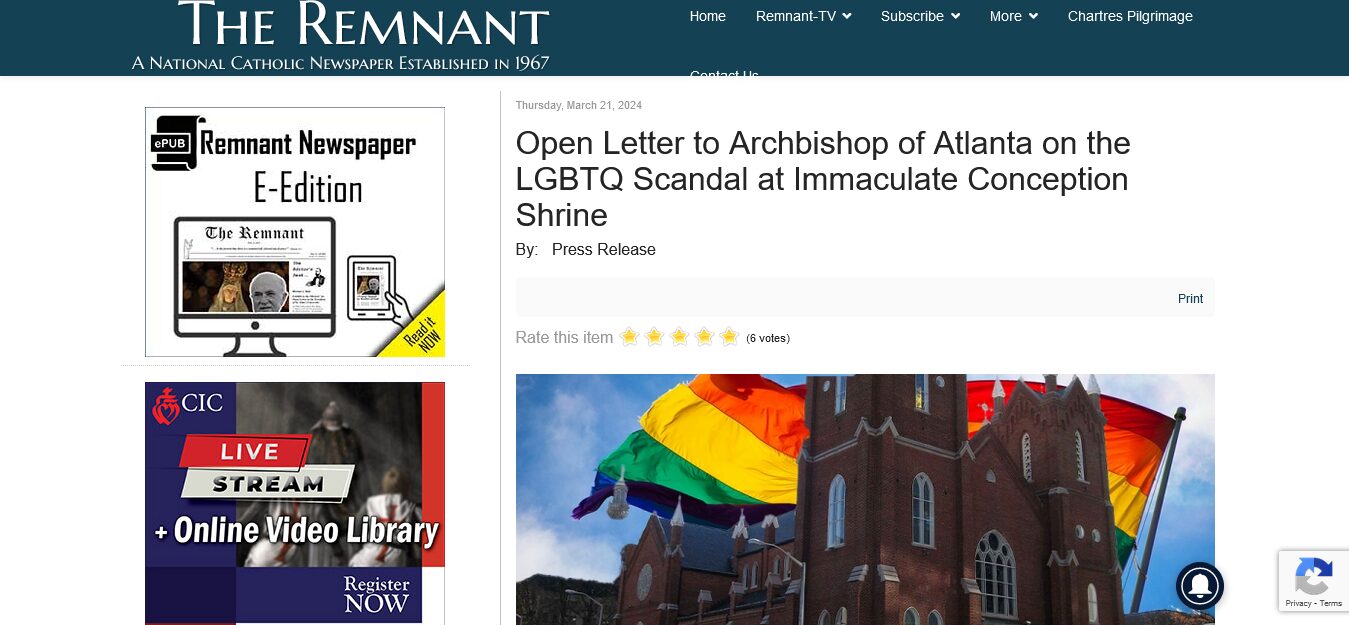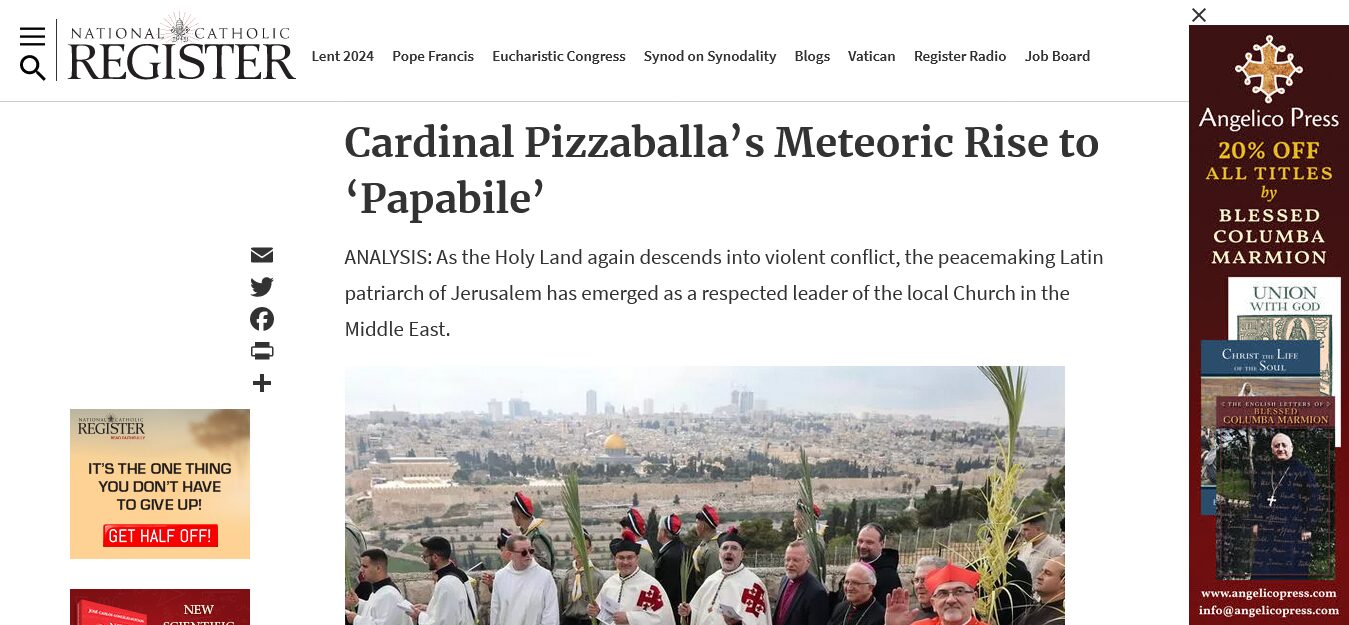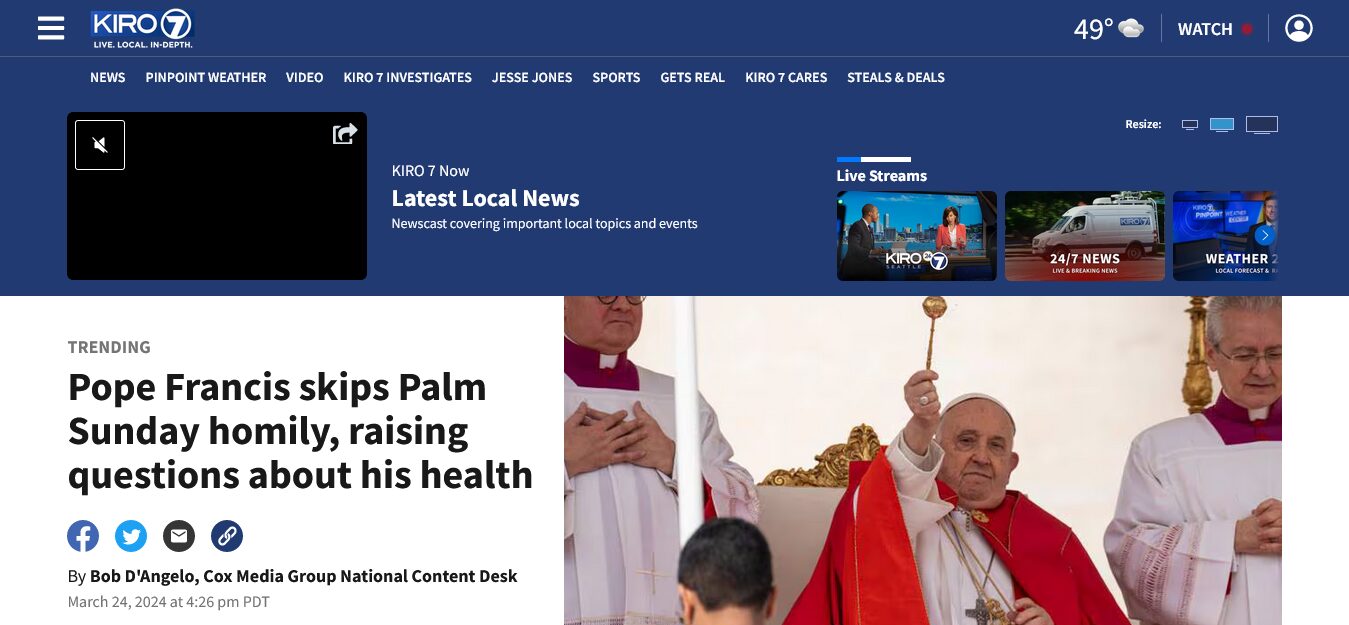How Opus Dei infiltrated the Knights of Columbus
USA: Google admits US Govt. regularly asks for identities of YouTube Video Audiences
A Meditation for Holy Week: There is no Salvation except with the Cross of Christ Jesus
by Br. Alexis Bugnolo
God could have forgiven sin by simply willing it. He did not have to order His Son to become incarnate and die on the Cross to redeem us.
Yet, God so loved the world that He gave His only begotten Son, so that all who believe in Him, may not perish, but have eternal life (John 3:16, Vulgate).
God’s incarnation was a scandal to the Jews, who refused to admit that God could take flesh and remain God. So they had Him betrayed by a false apostle and buffeted Him, falsely condemned Him and put Him to death.
But since He was God of Life, He rose from the dead, as the Saving God and as the Redeeming Man.
The passage of Jesus Christ from the glory of Palm Sunday through the horrors of the Cross to the Glory of Easter Sunday is the Mystery of Faith.
Here I use “mystery” and ”faith” differently that what you might suppose. I use the former as in a crime novel, and the latter as the theological virtue.
The path through the Cross and to the Resurrection was necessary for Christ’s Disciples. Because having become true Man, they could hear His teaching and accept it as either coming from a man or from the Son of God. Hence in them, both human faith in the man who stood before them and supernatural faith in the God who stood before them were joined together in a single act.
Human faith however cannot save. Only supernatural faith can save.
Of this supernatural faith, The Apostle Paul says, Without faith it is impossible to please God. (Hebrews 11:6)
Thus, to teach us to have supernatural faith it was necessary that Christ do something the acceptance of which would be impossible for human faith. And since human faith is a natural virtue and nature is inclined first of all to preserve its own life, the Cross was the necessary path through which Jesus Christ, as our Redeemer and our Teacher, had to walk to guide us by His example to eternal life.
This is why the Cross is inexplicable to the natural or carnal man. This is why our corrupt human nature draws back at the suggestion of penance, mortification, sacrifice and offering our lives up at risk for the sake of the Gospel. And this is why so few desire the grace of martyrdom, or even the lesser graces of being a victim soul or embracing a religious vocation of penance and sacrifice.
But only in the embrace of total self sacrifice, motivated out of Faith in Jesus, can we follow the call of truly supernatural faith, that which alone can lead us on the path from death to life, from this world to the Resurrection.
This is why, there is no Faith, no supernatural faith, without the Cross. And this is why we must embrace the Cross if we have faith, because that is what faith is about. And this is how we can renew the Church, each of us individually, while doing God’s will on earth.
Faith does not point the way to suicide, faith points the way of self sacrifice for God and neighbor, in the works of mercy, corporal or spiritual, and in the mortification of our corrupt nature in penance and conversion. We must begin with conversion of ourselves and the keeping of God’s commandments, but we must grow into the life of being merciful to others.
This is also why there is not fruit in the apostolate without the apostle accepting suffering. And this is why physical suffering is more necessary than any other kind of suffering. Physical suffering is the only kind that can kill you. Physical suffering, thus, is the only true sacrifice and risk. Though we should be cheerful when any suffering comes upon us on account of our service to God. When we embrace that with faith, we can merit great things for others.
And this is why Our Lord said, Greater love no man hath than he lay down his life for his friends (John 15:13).
Our Lord did not require that we do the greatest sacrifices. But He invites us to follow Him on that path. The salvation of countless souls depends upon that.
_________
CREDITS: The Featured Image is a photo by Br. Bugnolo of a grate to a side Chancel at Saint John Lateran.
HOLY LAND: Jews want Latin Patriarch, Pizzaballa, as next Pope
ITALY: VP of Italian Bishop’s Conference writes preface to Sodomitic Way of the Cross
 Editor’s Note: Adding blasphemy upon sacrilege, the Bishop argues that the Church needs to accept wider concepts of human sexuality and religiosity, if She is to move forward into the 21st century.
Editor’s Note: Adding blasphemy upon sacrilege, the Bishop argues that the Church needs to accept wider concepts of human sexuality and religiosity, if She is to move forward into the 21st century.
I am going to vomit.
Or, as they say on social media: O Lord, how long till you send the Asteroid down upon the Vatican?
VATICAN: Pope in gravely deteriorating condition
News Analysis by Br. Alexis Bugnolo
As we have seen in the past 11 years, the truth of history is not always reported in the daily news. Often we get misinformation or disinformation, and at key moments in history total outright lies, skewed just enough from the truth, as to hide it completely for years and years.
ANSA was the agency which told us Pope Benedict XVI had abdicated in February 2013, but hid their crime by using the English word, “resigned” (si è dimesso) rather than “renounced” (ha rinunciato), so that through the former word which was understood commonly as “abdicated” they could pass on the Big-Lie to justify a Conclave in 2013, when canonically speaking, no Conclave could have been legitimately called.
So today, when ANSA tell us that Pope Francis has no major “diseases”, while admitting for the first time that he has had 2 surgeries to his abdomen, who could deny that it is probably not only reasonable but also just to read behind the lines? Especially since they did not wait 24 hours to publish a report to squelch speculation about why the Holy Father would have omitted giving a homily on such an august day.
When Pope Benedict XVI died, 15 months ago, nearly, the narrative about his health condition deteriorated at an alarming speed of a few days, when in fact he had been suffering from kidney failure for years: a thing totally concealed by all Vatican press releases and investigated by none of the Vatican journalists of note or avocation.
Previous reports have shown that the Vatican is extremely cautious about Pope Francis’s condition, going so far as to rush him to Gemelli Hospital for what was later claimed to be minor infections. So it is clear that some thing or things chronic and serious is the true condition.
But the fact that Pope Francis omitted entirely the Homily from Palm Sunday Mass — not even permitting or asking any of the Cardinals, Bishops or Priests present to read it out loud even though canonically and liturgically it is a required part of that solemn liturgy — shows that Pope Francis’ health problems are more serious than are being admitted.
On top of that, Pope Francis’ disastrous spiritual state is completely ignored by the Vatican entirely, though it is clear to most Catholics that he is the grave habitual state of public sin for heresy, apostasy, schism, and just down right uncharitable meanness.
In normal times we should not publicly criticize the pope. But with Pope Francis public criticism is necessary to save souls from total loss of faith, seeing that his pontificate, except for the brief 5 month after his juridically valid election on January 30th of last year, has been a daily scandal to the Catholic world.
In sum, therefore, it is clear that Pope Francis is in a gravely deteriorating condition of body and soul, and that he has closed himself off from both the God of Mercy and any mortal remedy of a good counsel. In the meantime, the Vatican apparatus has gone into self-maintenance mode, and really does not give a bleep about God, souls or the Holy Father, just keeping up appearances.
Meanwhile, Catholics round the world, who understand all this well enough, are waiting for the news of Pope Francis’ demise: a thing they will great with relief, rejoicing and even celebration.
POLAND: New Kashubian Government is using Gangster Tactics against Polish People
 Editor’s Note: One of the facts about Donald Tusk, the new Prime Minister of Poland, which the MSM and Catholic controlled media won’t discuss, is that Tusk is not Polish by ethnicity, but Kashubian. And his maternal lineage appears to be Jewish, if one considers the surnames of the families involved. — This perhaps explains the vicious hatred of the Polish Catholic people being demonstrated by the new Tusk government.
Editor’s Note: One of the facts about Donald Tusk, the new Prime Minister of Poland, which the MSM and Catholic controlled media won’t discuss, is that Tusk is not Polish by ethnicity, but Kashubian. And his maternal lineage appears to be Jewish, if one considers the surnames of the families involved. — This perhaps explains the vicious hatred of the Polish Catholic people being demonstrated by the new Tusk government.
USA: Under Pope Francis, Bishops have begun to persecute Whistleblowers on sexual abuse by priests
VATICAN: Cardinal Fernandez & Pope Francis preparing “Attack on Human Dignity Document”
Editor’s Note: Lest anyone think the byline I have placed on this report is too strong, let one remember only one thing: the impenitent public manifest and pertinacious heretic only writes documents to justify his sin, error and perversion of thought.
So I think one can infallibly predict that somewhere, in the document to be published soon, will be a justification for “Gay Blessings” and all the sacrilege these two devil worshipers intend against the Divine Name.
Prove. Me. Wrong.
What the Russian Federation brings to the world
Anti-Globalist Talk Show, with AJ and Br. Bugnolo, March 25, 2024 A. D..
CANADA: How to go to the Hospital without a Mask, by an expert
Editor’s Note: This is my kind of Lady! This video brings back memories of all my encounters with the Police in Europe over not observing the Scamdemic tyrannies.
VATICAN: Pope Francis too weak to preach on Palm Sunday
NEWSWEEK: Catholic Conservatives better not dare move to depose Pope Francis
Critique by Br. Alexis Bugnolo
Here, above, in the linked article, is a very fine crafted piece of Globalist propaganda, written by someone who is desperately afraid that Catholics will sign on to the Sutri Initiative, and spent a lot of time crafting a piece of disinformation in an attempt to Gaslight the Catholic world. — Not that anyone who is seriously Catholic would believe or take counsel from anything in Newsweek Magazine. But since many Catholics of the other kind are the ones who are actually in charge (in munere, that is, “in office”) in the Church, Newsweek still holds out that they can have an effect.
The whole import of the article is to make it seem anti-Catholic to participate in a call to remove Pope Francis, while making it seem perfectly Catholic to support Pope Francis’ attempts to destroy the Catholic Church and Christianity forever, by main streaming Sabbatean God-hating practices like idol-worship, sodomy, blasphemy and sacrilege, going so far as to invoke the Most Sacred Name of God to approve of these abominations.
Aleks Phillips, the author of the article, is in fact a Jew, who pushes the Globalist Mythology of Climate Change. And you might even find out investigating his personal back ground that he is a cultural marxist and a sodomite, because those who write such articles praising Pope Francis are of that ilk.
If you are a Catholic, I would suggest that you take some time to stop and think why Newsweek would be asking Philips to tell Catholics what they should believe and what they should not believe.
And then you might realize not only what is the fundamental power structure in mass media, but what their ultimate Anti-Christic goal is: your eternal damnation.
Journals which tow the line like Newsweek are heavily funded. And those, who expose them for what they are, risk their personal safety and don’t get a cent for it. — This is eternal spiritual warfare, and FromRome.Info is on the winning side.
The sad reality is, that if you are a U.S. citizen, whatever of the two parties you vote for, Newsweek will continue to get tax-payer monies, perhaps, to keep pushing the Ideological Warfare Program against the Catholic Church, as many outlets have done since June 29, 1953, when it was declared.
ITALY: Conservative Freemasonic Parties Hold Conference in Subiaco
 Editor’s Note: The Globalists control nations through the manipulation of the political narrative, wherein all actors permitted on the stage are under their control. The Conservatives in Europe are among the finest play-actors in this theatre, and continually are labeled in the press as the friends of European Civilization. This is only a pretense, as can be seen at this conference where Fratelli d’Italia, the Masonic Italian party, which approved of the Digital ID, and did nothing to prosecute the perpetrators of the deaths of the Scamdemic or DeathVaxx, attended with full acceptance of the other political parties. Fratelli d’Italila is headed by Giorgia Meloni, the Aspen Club member who promised to reduce illegal immigration, but instead allowed it to increase 300%.
Editor’s Note: The Globalists control nations through the manipulation of the political narrative, wherein all actors permitted on the stage are under their control. The Conservatives in Europe are among the finest play-actors in this theatre, and continually are labeled in the press as the friends of European Civilization. This is only a pretense, as can be seen at this conference where Fratelli d’Italia, the Masonic Italian party, which approved of the Digital ID, and did nothing to prosecute the perpetrators of the deaths of the Scamdemic or DeathVaxx, attended with full acceptance of the other political parties. Fratelli d’Italila is headed by Giorgia Meloni, the Aspen Club member who promised to reduce illegal immigration, but instead allowed it to increase 300%.
These fakers are praised by the same ilk of men and women in the USA, who consistently hail these parties as the “only hope” for Europe. Social Media is full of their messages daily condemning the problems of Europe and the USA, while studiously avoiding any approval of any real solution.
For more about this, read my article, “How the Masconic Lodge manipulates Christians“.
After Catholic Charities exposed as a principal agent in Illegal Immigration, threats abound
USA: Trannies allowed to serve as acolytes at Mass
 Editor’s Note: It is clear that many Bishops have taken ‘Fiducia supplicans’ as the sign that Apostasy is O.K..
Editor’s Note: It is clear that many Bishops have taken ‘Fiducia supplicans’ as the sign that Apostasy is O.K..
Have you joined the Sutri Initiative yet? To get Pope Francis removed from the Papacy? Maybe it’s about time?















